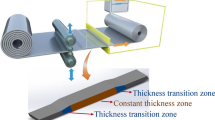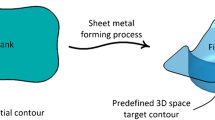Abstract
Combined isogeometric analysis (IGA) and shape optimization, this paper provides a method that can accurately analyze Tailor Rolled Blanks (TRB) and optimize its thickness profile continuously. While existed traditional methods can hardly solve these problems. TRB has a continuous transition between the thick and thin and a better surface quality. We found in IGA, two-dimension NURBS could present TRB geometry model exactly, but Kirchhoff shell element whose control points are allocated different thicknesses could not simulate TRB effectively. So, this paper uses three-dimension NURBS element to exactly present and accurately analyze TRB. It could avoid error caused by inaccurate presentation of geometry model and decrease error caused by solution field (displacement) approximation in numerical computation. Meanwhile, the positions of control points are taken as design variables in process of optimizing thickness profile. It can avoid the appearance of “unrealistic” shape and save lots of time spent in traditional tediously mesh updating as well as having better accuracy. This method makes accurate analysis and continuous thickness optimization of TRB become possible. It pushes the development of TRB engineering and extends the applications of IGA optimization. Several examples including benchmarks and application used the proposed method verified its effectivity, reliability and efficiency.


























Similar content being viewed by others
References
Bazilevs Y, Hughes TJR (2007) Weak imposition of Dirichlet boundary conditions in fluid mechanics. Comput Fluids 36(1):12–26
Bazilevs Y, Hughes TJR (2008) NURBS-based isogeometric analysis for the computation of flows about rotating components. Comput Mech 43(1):143–150
Bazilevs Y, Calo VM, Zhang Y, Hughes TJR (2006) Isogeometric fluid–structure interaction analysis with applications to arterial blood flow. Comput Mech 38(4–5):310–322
Bazilevs Y, Hsu MC, Scott MA (2012) Isogeometric fluid–structure interaction analysis with emphasis on non-matching discretizations and with application to wind turbines. Comput Methods Appl Mech Eng 249–252:28–41
Bazilevs Y, Long CC, Marsden AL (2013) Fluid–structure interaction simulation of pulsatile ventricular assist devices. Comput Mech 52(5):971–981
Benson DJ, Bazilevs Y, Hsua MC, Hughes TJR (2010) Isogeometric shell analysis: The Reissner–Mindlin shell. Comput Methods Appl Mech Eng 199:276–289
Benson DJ, Hartmann S, Bazilevs Y, Hsu MC, Hughes TJR (2013) Blended isogeometric shells. Comput Methods Appl Mech Eng 255:133–146
Braibant V, Fleury C (1984) Shape optimal design using b-splines. Comput Methods Appl Mech Eng 44:247–267
Can H, Yi G, Jitao D, Chengzhan C, Qijun C (2012) Shape rolling simulation of tailor rolled blanks based on deform-3D. Appl Mech Mater 101–102:897–900
Cardoso RPR, Cesar de Sa JMA (2012) The enhanced assumed strain method for the isogeometric analysis of nearly incompressible deformation of solids. Int J Numer Methods Eng 92(1):56–78
Cayssials F (2000) An industrial application of specific forming limit curves for tailor-welded blanks. In: Proceedings of the International Deep Drawing Research Group, Ann Arbor, Michigan, USA, 5–7 June 2000
Chatti S, Heller B, Kleiner M et al. (2002) Forming and further processing of tailor rolled blanks for lightweight structures. In: Proceedings of the 7th International Conference on Technology of Plasticity, Yokohama, Japan, October 27-November 2002
Cho S, Ha SH (2009) Isogeometric shape design optimization: exact geometry and enhanced sensitivity. Struct Multidiscip Optim 38:53–70
Choi JH (2002) Shape design sensitivity analysis and optimization of general plane arch structures. Finite Elem Anal Des 32:119–136
Christensen PW, Klarbring A (2009) An introduction to structural optimization. Springer, New York
Chuang CH, Yang RJLG, Mallela K, Pothuraju P (2008) Multidisciplinary design optimization on vehicle tailor rolled blank design. Struct Multidiscip Optim 35:551–560
Cottrell JA, Hughes TJR, Bazilevs Y (2009) Isogeometric analysis: toward integration of CAD and FEA. Wiley, New York
Dedè L, Borden MJ, Hughes TJR (2012) Isogeometric analysis for topology optimization with a phase field model. Arch Comput Method sin Eng 19:427–465
Defourny J, Wouters P (1998) FEM modeling of the tailored blank sensitivity to material and welded zone properties. Final Report of European Commission Project, Technical Steel Research, Properties and In-Service Performance
Dornisch W, Klinkel S, Simeon B (2013) Isogeometric Reissner–Mindlin shell analysis with exactly calculated director vectors. Comput Methods Appl Mech Eng 253:491–504
Fußeder D, Simeon B, Vuong AV (2015) Fundamental aspects of shape optimization in the context of isogeometric analysis. Comput Methods Appl Mech Eng 286:313–331
Geiger M, Merklein M (2007) Sheet metal forming—a new kind of forge for the future. Key Eng Mater 344:9–20
Haslinger MRAE (2003) Introduction to shape optimization: theory, approximation, and computation. SIAM, Philadelphia
Hassani B, Khanzadi M, Tavakkoli SM et al. (2009) Isogeometric shape optimization of three dimensional problems. In: 8th World Congress on Structural and Multidisciplinary Optimization, Lisbon, Portugal, 1–5 June 2009
Hassani B, Tavakkoli SM, Moghadama NZ (2011) Application of isogeometric analysis in structural shape optimization. Sharif Univ Technol, ScientiaIranica 18(4):846–852
Herskovits J, Dias G, Santos G, Soares CM (2000) Shape structural optimization with an interior point nonlinear programming algorithm. Struct Multidiscip Optim 20:107–115
Hirt G, Dávalos JDH (2012) Tailored profiles made of tailor rolled strips by roll forming—part 1 of 2. Steel Res Int 83:100–105
Hirt G, Abratis C, Ames J, Meyer A (2005) Manufacturing of sheet metal parts from tailor rolled blanks. J Technol Plastic 30:1–12
Hughes TJR, Cottrell JA, Bazilevs Y (2005) Isogeometric analysis: CAD, finite elements, NURBS, exact geometry and mesh refinement. Comput Methods Appl Mech Eng 194:4135–4195
Kiendl J, Bletzinger KU, Linhard J, Wüchner R (2009) Isogeometric shell analysis with Kirchhoff–love elements. Comput Methods Appl Mech Eng 198:3902–3914
Kopp R, Wiedner C, Meyer A (2005) Flexibly rolled sheet metal and its use in sheet metal forming. Adv Mater Res 6–8:81–92
Korobenko A, Hsu MC, Akkerman I, Tippmann J, Bazilevs Y (2013) Structural mechanics modeling and FSI simulation of wind turbines. Math Models Methods Appl Sci 23(2):249–272
Liu J, Gomez H, Evans JA, Hughes TJR, Landis CM (2013) Functional entropy variables: a new methodology for deriving thermodynamically consistent algorithms for complex fluids, with particular reference to the isothermal Navier–Stokes–Korteweg equations. J Comput Phys 248:47–86
Lorenzis LD, Temizer I, Wriggers P, Zavarise G (2011) A large deformation frictional contact formulation using NURBS-based isogeometric analysis. Int J Numer Methods Eng 87(13):1278–1300
Merklein M, Johannes M, Lechner M, Kuppert A (2014) A review on tailored blanks—production, applications and evaluation. J Mater Process Technol 214:151–164
Meyer A, Wietbrock B, Hirt G (2008) Increasing of the drawing depth using tailor rolled blanks—numerical and experimental analysis. Int J Mach Tools Manuf 48:52–531
Muhrund Bender KG (2013) http://www.mubea.com (10.06.13)
Nadir W, Kim IY, Weck OL et al. (2004) Structural shape optimization considering both performance and manufacturing cost. In: 10th AIAA/ISSMO Multidisciplinary Analysis and Optimization Conference, Albany, New York, 30 Aug-1 Sept 2004
Nagy AP, Abdalla MM, Gurdal Z (2010) Isogeometric sizing and shape optimization of beam structures. Comput Methods Appl Mech Eng 199:1216–1230
Piegl L, Tiller W (1997) The NURBS book (monographs in visual communication), 2nd edn. Springer, New York
Qian XP (2010) Full analytical sensitivities in NURBS based isogeometric shape optimization. Comput Methods Appl Mech Eng 199:2059–2071
Rogers DF (2001) An introduction to NURBS with historical perspective. Academic, San Diego
Ryabkov N, Jackel F, van Putten K, Hirt G (2008) Production of blanks with thickness transitions in longitudinal and lateral direction through 3D-strip profile rolling. Int J Mater Form 1(1):391–394
Sagstro¨ E, Larsson H, Nilsson B et al. (2000) The formability of tailor-welded blanks depending on welding methods and material combinations, In: Proceedings of the International Deep Drawing Research Group, Ann Arbor, Michigan, USA, 5–7 June 2000
Samareh A (1999) A survey of shape parameterization techniques. NASA Langley Technical Report
Seo YD, Kim HJ, Youn SK (2010) Shape optimization and its extension to topological design based on isogeometric analysis. Int J Solids Struct 47:1618–1640
Streitberger HJ, Dössel KF (2008) Automotive paints and coatings. Wiley-VCH, Weinheim
Svanberg K (1987) The method of moving asymptotes: a new method for structural optimization. Int J Num Methods Eng 24:359–373
Verhoosel CV, Scott MA, Hughes TJR, Borst DR (2011) An isogeometric analysis approach to gradient damage models. Int J Numer Methods Eng 86(1):115–134
Vollertsen F, Lange K (1998) Enhancement of drawability by local heat treatment. CIRP Ann Manuf Technol 47:181–184
Wall WA, Frenzel MA, Cyron C (2008) Isogeometric structural shape optimization. Comput Methods Appl Mech Eng 197:2976–2988
Acknowledgments
This work was supported by the State Key Program of National Natural Science of China (61232014), National Science Foundation of China (11472101), State Key Program of National Natural Science of China (61232014), Science Fund of State Key Laboratory of Advanced Design and Manufacturing for Vehicle Body (71575003) and Hunan Provincial Natural Science Foundation of China (2015JJ3037).
Author information
Authors and Affiliations
Corresponding author
Rights and permissions
About this article
Cite this article
Ding, C.S., Cui, X.Y. & Li, G.Y. Accurate analysis and thickness optimization of tailor rolled blanks based on isogeometric analysis. Struct Multidisc Optim 54, 871–887 (2016). https://doi.org/10.1007/s00158-016-1448-8
Received:
Revised:
Accepted:
Published:
Issue Date:
DOI: https://doi.org/10.1007/s00158-016-1448-8




